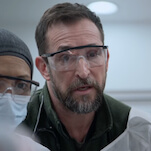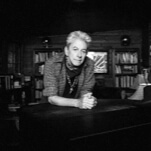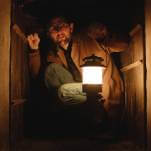Helix throws a bunch of talent at flat characters

How has there never been a TV series about the Centers For Disease Control And Prevention trying to tamp down a potentially threatening viral outbreak? The most basic answer is that such a story couldn’t possibly have more than a season’s worth of material. Unless, the series were going to abruptly become a post-apocalyptic one, but other shows from 24 to Buffy have taken that “a story in a season” approach and used it to great effect when building worlds and characters. Diseases are inherently terrifying, strange invaders that can tear apart the body from within, and they can make for gross yet involving television.
Helix, the first of Syfy’s many bids this year to reclaim the science-fiction TV throne it relinquished several years ago, takes this basic idea and gives it a dark, mysterious twist. The virus may not be entirely natural. The virus might be the gateway to some other story entirely, one with—say it with us now—a deep, complicated mythology that will take years to unravel. There are times in its first three episodes when Helix seems to exist primarily to service that mythology, rather than the nitty-gritty of telling a story about an overwhelmed CDC staff trying to shut down an outbreak above the Arctic Circle. Though, the show gets enough right to be worth a season pass for those interested in the genre.
The series’ pilot opens ominously enough, with men entering a room at an Arctic research facility whose occupants all appear to have died horribly, the strains of “Do You Know The Way To San Jose” increasing the horror via ironic juxtaposition. When the investigators lean over one of the men’s corpses, something strange appears to be wiggling in his throat, just beneath the surface of the skin, only for the episode to cut to the enjoyably jaunty title card. In these moments, the series underscores its central idea, one that will be familiar to science-fiction fans going way back: Institutions are not your friend, and they cover up murderous intent with happy surfaces that ultimately prove hollow.
Investigating the potential outbreak is a CDC team led by Billy Campbell’s Dr. Alan Farragut, who has a personal connection to the team at the research facility. Joining him will be his ex-wife, Julia (Kyra Zagorsky); his potential new lover and former student, Sarah (Jordan Hayes); a military man with mysterious allegiances (Mark Ghanimé); and the usual band of investigative misfits, as though Farragut was intent on dragging an entire NCIS team featuring only characters played by Pauley Perrette with him to the farthest reaches of the planet. The team arrives to discover that all is not exactly as it seems and the research facility’s head, Dr. Hiroshi Hatake (Hiroyuki Sanada), may not have the best interests of everyone involved at heart. Sure, there are similarities to The Andromeda Strain here—right down to the inevitability of the outbreak coming from outer space—but any science-fiction fan worth his or her salt will be able to hum these choruses without a second thought.





















![Rob Reiner's son booked for murder amid homicide investigation [Updated]](https://img.pastemagazine.com/wp-content/avuploads/2025/12/15131025/MixCollage-15-Dec-2025-01-10-PM-9121.jpg)


















